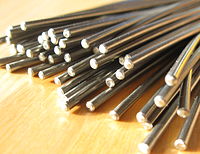
Photo from wikipedia
Abstract High entropy shape memory alloys (HESMAs) represent a relatively young class of functional materials. They show a reversible martensitic phase transformation which allows to exploit shape memory effects at… Click to show full abstract
Abstract High entropy shape memory alloys (HESMAs) represent a relatively young class of functional materials. They show a reversible martensitic phase transformation which allows to exploit shape memory effects at relatively high temperatures. HESMAs represent ordered complex solid-solutions. Their high temperature phase is of B2 type, and various elements (e.g. Ni, Cu, Ti, Zr, Hf) occupy sites in specific sub-lattices. In the present work, we study the processing and the functional properties of HESMAs. We study effects of chemical complexity on solidification microstructures and martensitic transformations. Binary, ternary, quaternary, quinary and senary model alloys were investigated using advanced microstructural and thermal characterization methods. The results show that element partitioning during solidification results in a redistribution of individual alloy elements in dendritic/interdendritic regions. Surprisingly, the atomic ratios of the two groups of elements which occupy the Ni- (first group: Ni, Cu and Pd) and Ti-sub-lattice (second group: Ti, Zr, Hf) are maintained. This allows the material to form martensite throughout its heterogeneous microstructure. The effect of chemical complexity/composition on martensite start temperatures, MS, is discussed on the basis of valence electron concentrations, cV. Some of the alloys fall into MS(cV)-regimes which are uncommon for classical Ni-Ti-based shape memory alloys. In the present work, a new HESMA of type NiCuPdTiZrHf was identified which has the potential to provide maximum shape memory strains close to 15%.
Journal Title: Intermetallics
Year Published: 2020
Link to full text (if available)
Share on Social Media: Sign Up to like & get
recommendations!